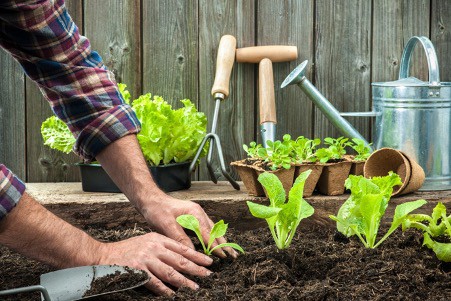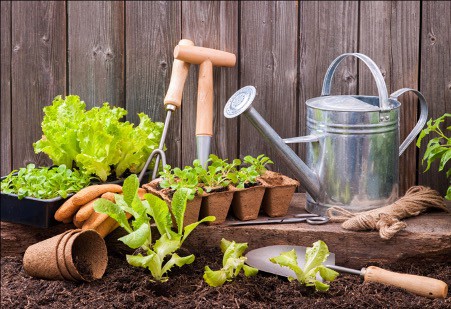It can be exciting as well as daunting to make your own garden. We all believe it is a place that helps us relax and forget our busy lives for a while. No doubt, it’s a time-consuming process to maintain and sustain a garden. It all begins with a single grass patch and as the time passes, it gets converted into a lovely garden area with lots of flowers, veggies, and fruits.
Gardening requires skills, and dedication when it is about growing plants. If you are a first-time gardener then follow these simple 10 tips.
-
Choose an appropriate location
Contents
Picking up a good location is key. While choosing the area, you should ensure that it gets exposed to sunlight for around 6 hours. This is so because most fruits and vegetables need proper sunlight to grow.
Greens, herbs, and veggies can also grow in partial shade. Also, think about how accessible your space is for the purpose of watering, picking, and caring for your plants.
-
Choose what type of garden you want
After finding that perfect location, you need to choose the type of plant you want. It can be beautiful flowers to make you feel refreshed throughout or green veggies to stay healthy. It’s your decision what you want to grow. Seek your help at tree and garden care services Austin.
Once you have decided on it, all you need to do is take baby steps to make it a perfect garden. Seed packaging and plant labels will tell you what grows best in your area.
-
Know about the soil types
Before you start, make sure you have proper knowledge of the soil. It’s very important to examine the soil’s quality; you should be able to easily crumble it with bare hands.
If it is hard in nature, it will make it difficult for plants to grow and flourish. Furthermore, their roots will not be that strong.
Mostly, it is significant to offer organic soil that is fertile at the same time to plants. If you are willing to enjoy fruits and vegetables from your own garden, then you need to invest in the right kind of soil.
-
Use the right gardening tools
After your planning is done, you will require gardening equipment to get started with the process. Here are a few equipment and tools that you will need in the process:
- Pruning Scissors: This tool is very important for every gardener. You will be using them to trim the unwanted parts of plants and maintain them.
- Trowel and spade for digging: Furthermore, you will use a garden fork for eliminating weeds from the older plants.
- Watering Tools: You can use the watering can and garden pipe. Garden pipe is perfect for bigger areas like trees. Since small plants cannot take high amounts of water pressure, you should prefer using a watering can.
- Tools for weeding: For this, you will need a forked trowel followed by a knife used for gardening purposes.
-
Decide on the space for every plant
Focusing on the spacing and location of your plant is important. Plants need their own space just like us. If you are not sure of the spacing criterion, then helpful gardening blogs like livegrowgarden.com are there for your ultimate rescue. If your plants are extremely close to each other, then they will either die or their growth may get affected. Hence, it’s a good idea to do labelling for your plants.
-
Make a schedule for watering plants
Though watering helps plants to sustain in the long-run but giving them excess water can damage them. You should water them in such a manner that the soil absorbs it completely. New plants need to be watered on a daily basis for sustainability and stronger roots. However, developed plants should be watered twice or thrice a week depending on the weather conditions.
-
Use Organic Fertilizer
Fertilizing the ground is an important step to add nutrients and minerals. Use organic materials such coffee, tea bags, etc. as compost for your garden. It will also help you to reduce your carbon footprint.
-
Vegetable gardening For Beginners
There’s absolutely nothing like fresh veggies coming out straight from your garden. These vegetables are more juicy and fresh. Every region has a different planting time mainly based on its weather and every vegetable has its temperature preferences.
Beginners can start with easy to grow vegetables like tomatoes, radish, and lettuce. Once you become a pro you can grow vegetables like cabbage, Broccoli, etc. You can get more information here.
-
Experiment with Mulch
Mulch can save your time whether you are willing to plant flowers or vegetables in your garden. It helps in offering the required nutrients to the soil and protecting it from erosion. Mulch is nothing but any basic material that helps in covering the soil. It retains moisture in the soil, keeps it cool and adds to the aesthetics of the garden.
-
Be Patient
Plants take time to grow, so remain calm and have patience. They require maintenance and it’s one of the most rewarding things you can give to your space. Get rid of pests and diseases by taking the right measures. It’s very important to water your plants regularly and provide them enough nutrients once in a while.
Starting a garden is not as scary as it seems. Choose your plants carefully like sun-loving plants in a sunny spot and heat-tolerant plants in warm climates.
Do your homework properly and pick varieties that will grow well where you live and space you have. We hope that this article helps you with these tips. Happy Gardening!

